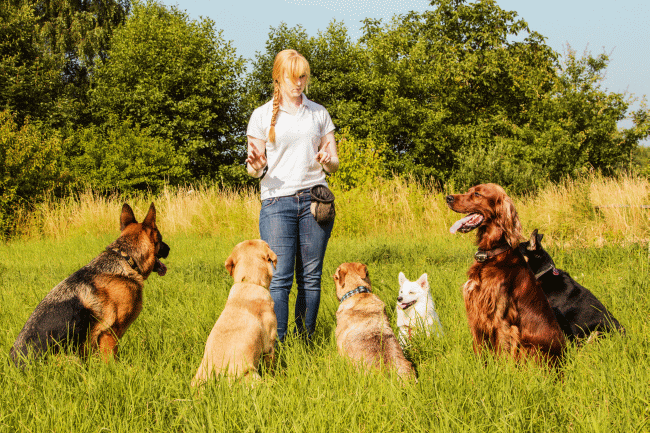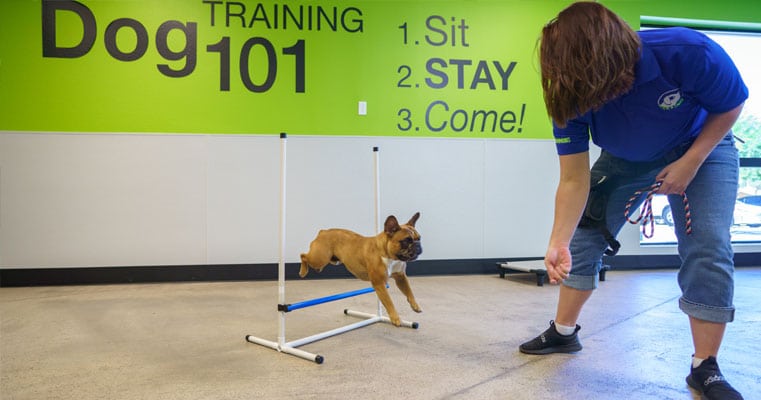Novice's Guide to Effective Dog Training in the house
Effectively training a pet at home needs a nuanced understanding of canine behavior and efficient interaction techniques. Establishing clear training objectives, utilizing top notch rewards, and maintaining consistency throughout family participants are critical elements. Integrating training right into daily regimens can enhance both engagement and retention. Nevertheless, many novice trainers experience difficulties that might impede progress. To navigate these complexities successfully, it's necessary to check out numerous vital facets that can change your strategy and bring about an unified relationship with your pet dog. What essential principles should every beginner grasp to make sure success?
Recognizing Dog Behavior
Comprehending pet behavior is necessary for efficient training and fostering a harmonious partnership between human beings and their canine buddies - Puppy Training. Pets interact mostly via body language, articulations, and faces, making it critical for proprietors to analyze these signals precisely. Acknowledging habits such as tail wagging, growling, or cowering can supply understandings into a dog's emotion and intents
Additionally, understanding the all-natural instincts of dogs, such as their pack attitude, helps proprietors establish leadership duties within the household. This is crucial for developing a structured atmosphere where pet dogs feel secure and are extra responsive to training. Canines are additionally affected by their socialization experiences; early direct exposure to numerous atmospheres, individuals, and various other animals can significantly form their actions later on in life.
Typical behavior issues, such as aggression, anxiety, or too much barking, often originate from misconceptions or unmet requirements. Observing and dealing with these concerns without delay can avoid rise and guarantee a favorable training experience. By cultivating a deep understanding of canine habits, owners can customize their training approaches to match their canine friends, ultimately resulting in a mannerly and pleased pet dog.

Important Training Devices
A well-appointed training room can dramatically boost the performance of dog training at home. Important training tools make certain that both the fitness instructor and the pet can participate in productive sessions that cultivate understanding and bonding.

Purchasing a tough leash and a comfy, well-fitting collar or harness is important for safety and security and control. These tools aid establish boundaries and guarantee the pet dog remains secure during training. Furthermore, a marked training location, without diversions, aids focus for both the pet and the trainer.
Educating aids such as training pads, cones, or dexterity devices can likewise enhance the experience by presenting variety and difficulties. Last but not least, having a note pad or electronic application for tracking development can be invaluable, enabling you to keep in mind successes and areas for enhancement. Utilizing Read Full Report these important devices will produce a favorable training atmosphere and lay the structure for effective learning.
Producing an Educating Regimen
Developing a regular training routine is crucial for efficient pet training at home. A well-structured regular not only assists in reinforcing wanted habits however also supplies your dog with a complacency and predictability. To create an effective training routine, begin by identifying particular training goals, such as basic commands, chain strolling, or house-training.
Select an assigned time every day for training sessions, ideally when your pet is sharp and responsive. Sessions must be brief, about 5 to 15 minutes, to preserve focus and prevent tiredness. Uniformity in timing and environment will enhance your dog's learning experience.
Incorporate training into daily tasks to strengthen skills. Method commands throughout walks or mealtime, which incorporates finding out into all-natural routines. Additionally, stay flexible and adjust the regular as required, suiting your pet's energy levels and mood.
Favorable Reinforcement Strategies

When applying favorable support, it is necessary to choose rewards that are encouraging for your dog. High-value treats, such as small items of hen or cheese, can be particularly reliable throughout training sessions. Additionally, varying the benefits can keep your canine's navigate here rate of interest and excitement.
Begin with easy commands, like "sit" or "stay," and progressively progress to more complicated tasks. Consistency is crucial; ensure that all member of the family utilize the exact same commands and reward systems to avoid complication.
In addition, it is crucial to continue to be patient and avoid disappointment. Pets, like human beings, learn at their own rate. By cultivating a supportive training atmosphere via favorable reinforcement, you can improve your dog's discovering experience while strengthening the bond between you and your furry friend, preparing for successful training end results.
Typical Educating Challenges
While educating a canine in the house can be a satisfying experience, it typically includes a collection of common challenges that can evaluate both patience and consistency. One common problem is disturbance. Pet dogs may become easily sidetracked by noises, movements, or also aromas in their environment, making it tough to keep their emphasis throughout training sessions.
Another difficulty is inconsistency in commands and support. It can prevent and perplex the canine development if family members utilize various signs or benefits. Developing a unified technique is essential for efficient interaction.
In addition, canines can experience stress or anxiety, specifically if they do not recognize what is expected of them. This can bring about undesirable behaviors, such as barking or chewing.
Lastly, the timing of support is important. Postponed rewards can diminish the performance of positive support, as pet dogs might stop check my source working to connect the behavior with the incentive.
Getting rid of these challenges calls for dedication, clear interaction, and a structured training plan - Puppy Training. Acknowledging and resolving these typical challenges will certainly lead the way for a more delightful and successful training experience in your home
Conclusion
In final thought, effective pet training at home demands a comprehensive understanding of canine actions and reliable interaction methods. By developing clear training objectives and making use of high-grade treats alongside positive reinforcement, the training procedure ends up being more fulfilling for both the canine and the instructor.
Establishing a regular training regimen is necessary for reliable canine training at home.Favorable reinforcement strategies are essential to effective dog training, advertising preferred behaviors through benefits instead than punishment. By cultivating a helpful training environment with positive reinforcement, you can boost your pet dog's knowing experience while enhancing the bond between you and your furry friend, laying the groundwork for successful training outcomes.
In conclusion, effective pet dog training at home demands a detailed understanding of canine habits and efficient interaction strategies. By establishing clear training goals and making use of high-quality treats along with favorable support, the training procedure comes to be much more satisfying for both the pet and the trainer.